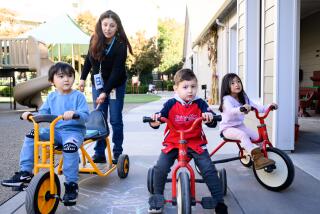N.C. Institution Has About 33% Success Rate : School Tries to Help Violent Youths Return to Society
- Share via
CHARLOTTE, N. C. — Of the 32 boys and six girls at Morgan School, some have killed people, burned buildings or shot at airplanes. Some are schizophrenics. Many were abused as youngsters.
One student named Dave was so disruptive a year and a half ago, when he first flew home to Charlotte from a private school for severely disturbed youngsters in Arizona, that the pilot was nearly forced to bring the plane down in Texas.
Even now, Dave’s voice slurs from the effects of three psychotropic medications. He has tried other schools, “too many to tell you,” he says.
Opened by Court Order
But here at Morgan School, opened 2 1/2 years ago after a federal court ordered North Carolina to provide education for violent youngsters, students like Dave stand as good a chance as anyone to beat the odds and return to normal school.
“You hear about the ‘six-hour retarded kid,’ the one who fails in school but can cope on the outside, in jobs or whatever,” Principal Lloyd Wimberley said.
“But this population doesn’t disappear. My guys don’t go away. They get to be a real problem for the community,” he said, apologizing to a visitor for his black eye, inflicted when breaking up a student fight.
Morgan boasts several extraordinary statistics compared to other public school programs for the emotionally disturbed. Roughly a third of its students eventually return to mainstream public schools, impressive considering that three-quarters of its student body has displayed violent behavior.
Short Average Stay
The average stay at Morgan is six months or less, compared to an average of two to three years elsewhere.
“There are programs that won’t let the kids go,” Wimberley said. “Here, we let them go.”
And the black-to-white student ratio is 60% to 40%, compared to a national average in excess of 80% to 20%--the result, Wimberley said, of elaborate prescreening aimed at ensuring that students are truly emotionally handicapped and not merely children whom regular teachers want to be rid of.
In line with the national trend, however, Morgan is predominantly male.
No Miracle Cures
The school, which is housed in a 60-year-old brick building that was originally one of Charlotte’s first black elementary schools, does not claim to have a miracle cure for Dave and others like him.
But Wimberley thinks schools for the emotionally handicapped around the country sometimes forget that they are dealing in education first and foremost, not therapy.
“We try to take the students seriously as students and not think about their ‘clinical problem,’ ” he said.
The classes are small--six students, with one teacher and an aide. Students can earn credit toward a high school diploma.
Behavior Points
In common with other such schools, Morgan tries to change behavior by assigning students to different levels, based on the number of hourly behavior points they earn.
And every student’s point chart is on public display in classrooms for all to see: a visible, graphic monument to each youngster’s behavior or misbehavior each week.
Students at levels 1 and 2 have few privileges. They must eat in class and are forbidden to go to the bathroom by themselves. Those who earn their way to level 5 may eat lunch off campus or visit the Dragon’s Den, the student lounge, which has a stereo and pool table.
If a student behaves well enough to stay on Level 5 for four weeks, he can begin preparing for transition back to regular school.
More to Read
Sign up for Essential California
The most important California stories and recommendations in your inbox every morning.
You may occasionally receive promotional content from the Los Angeles Times.













